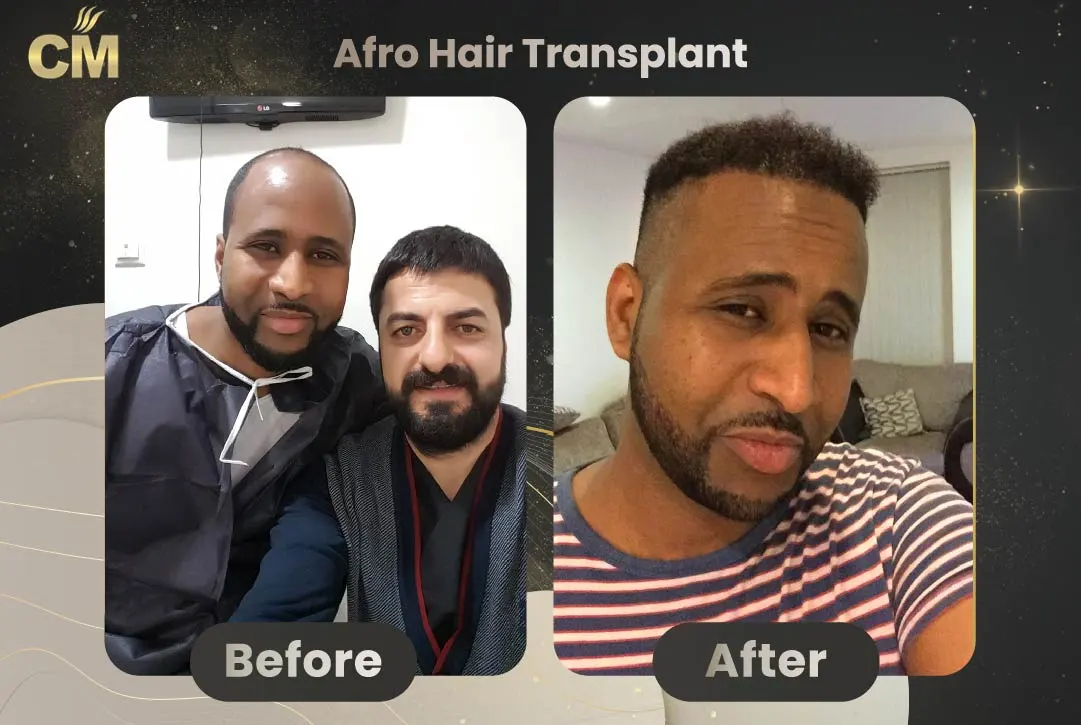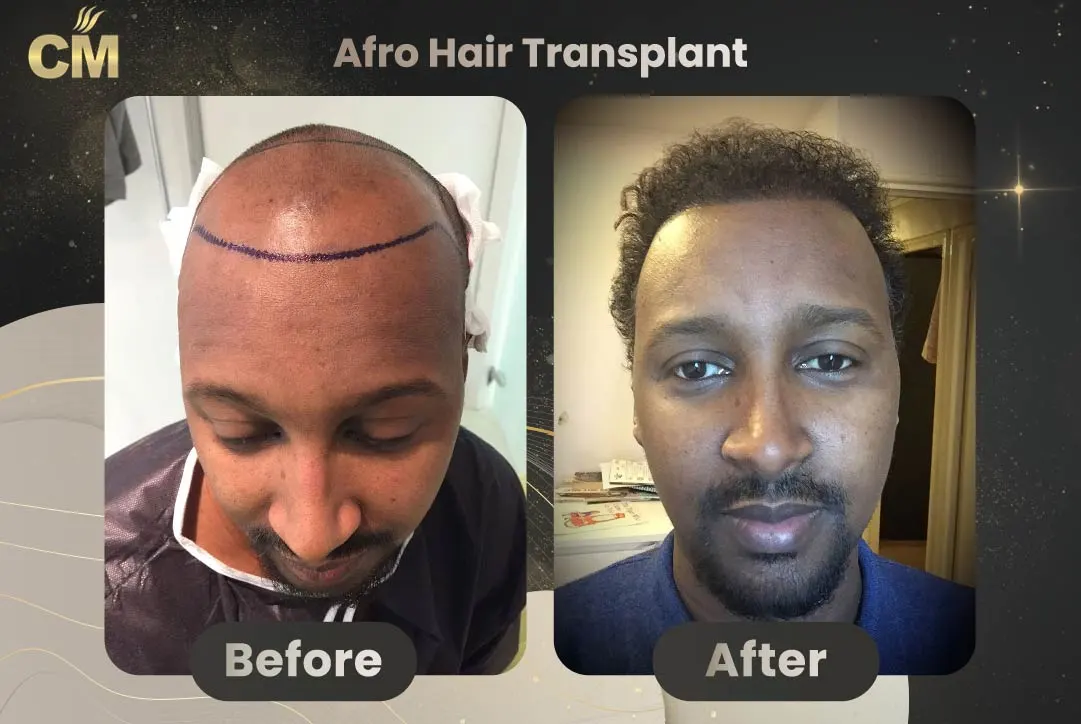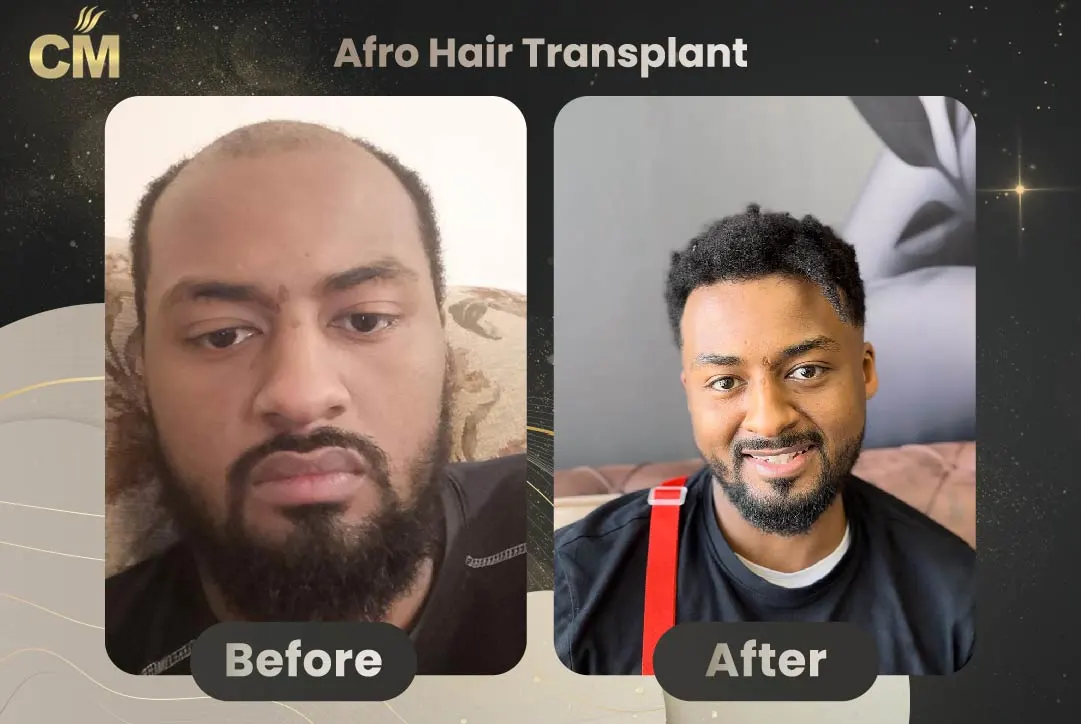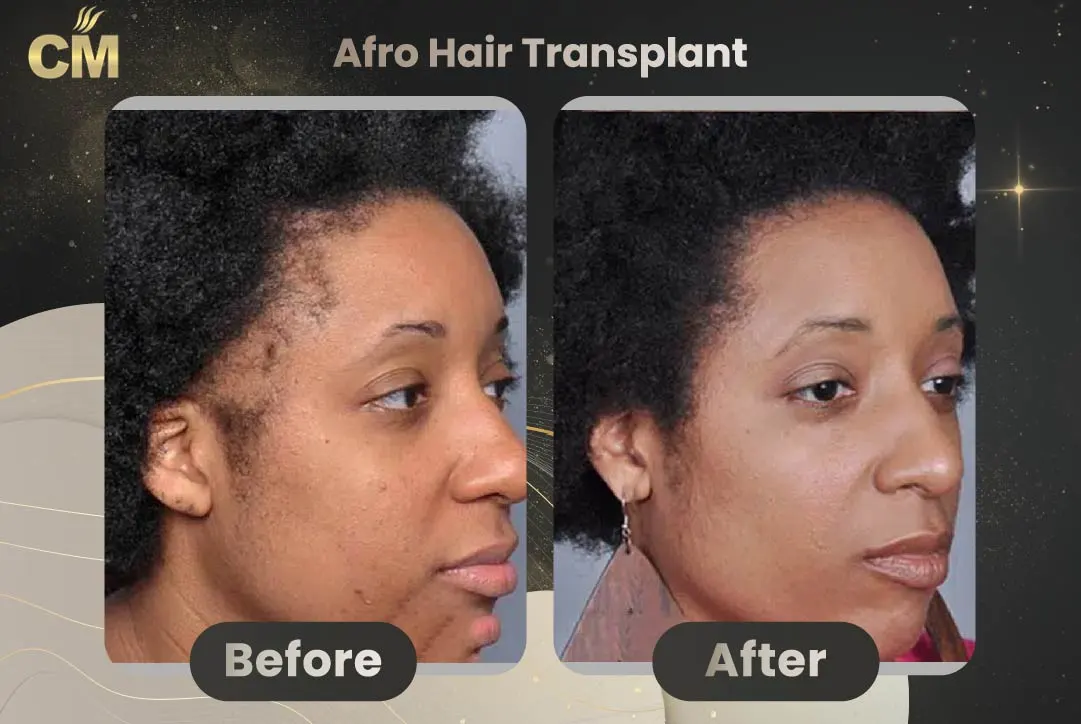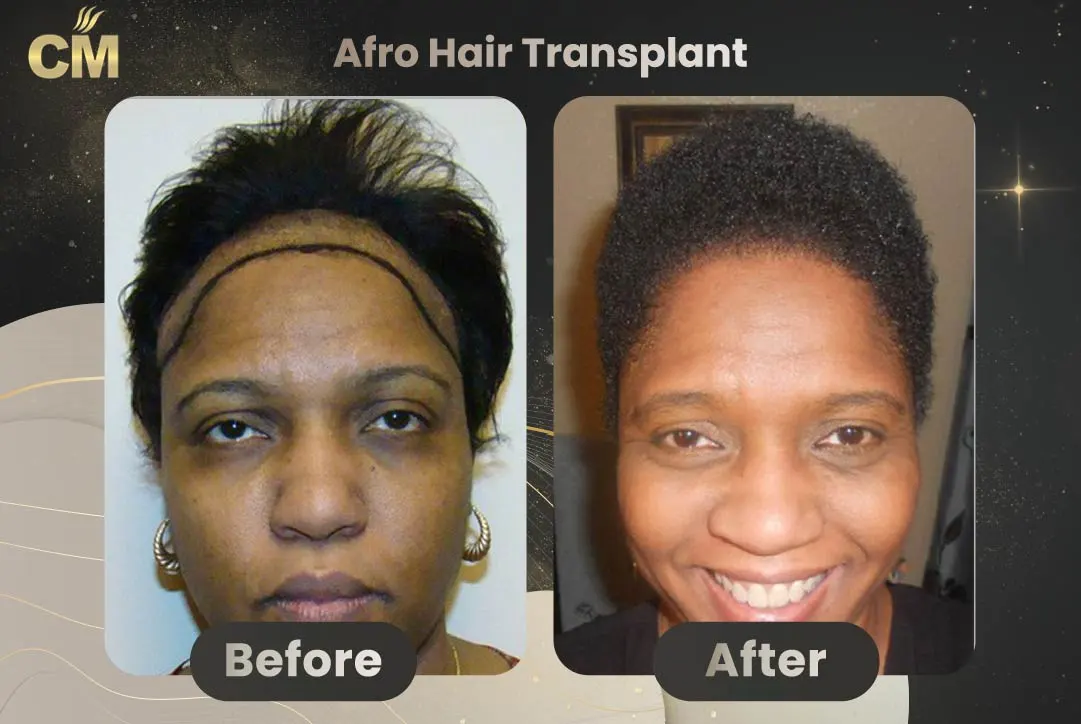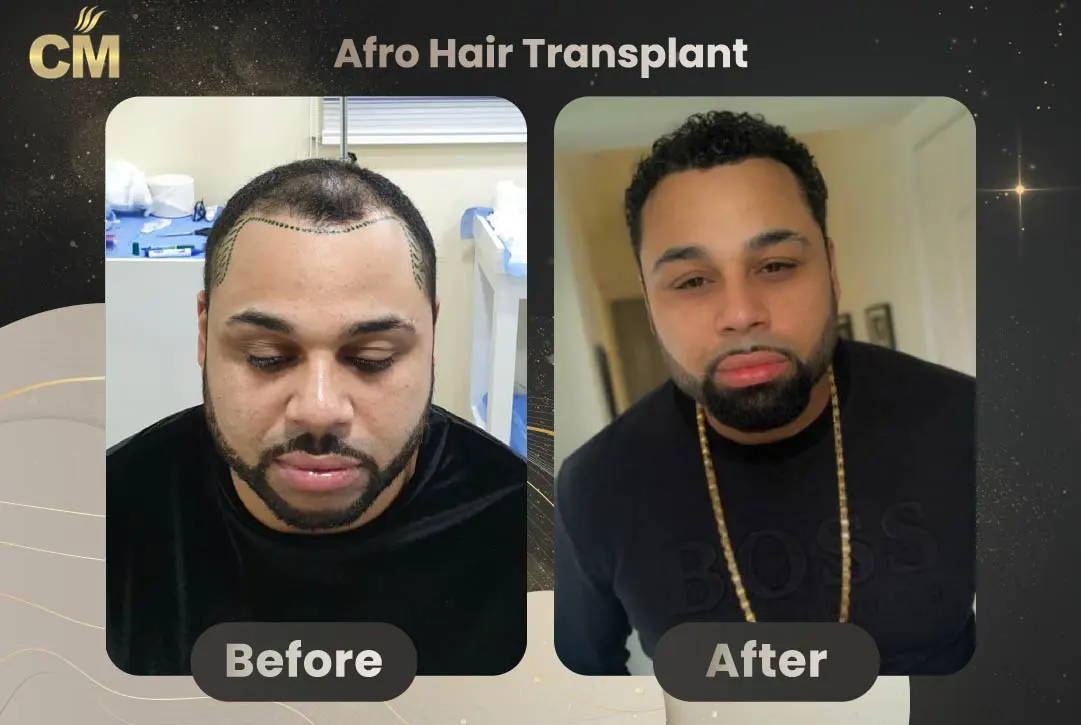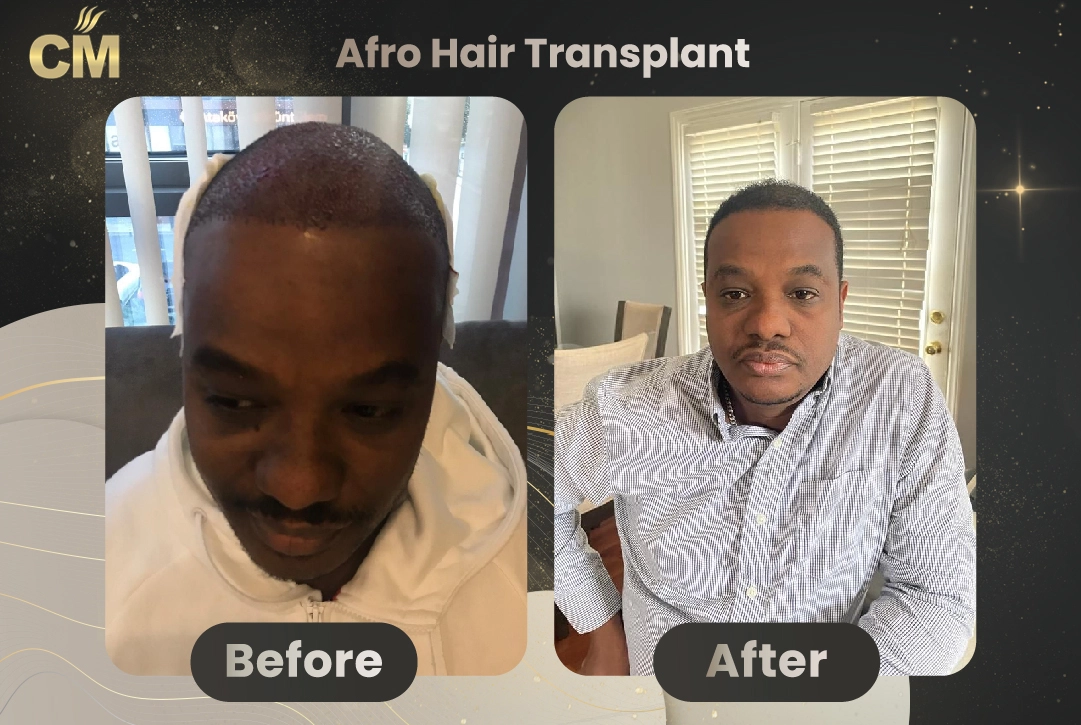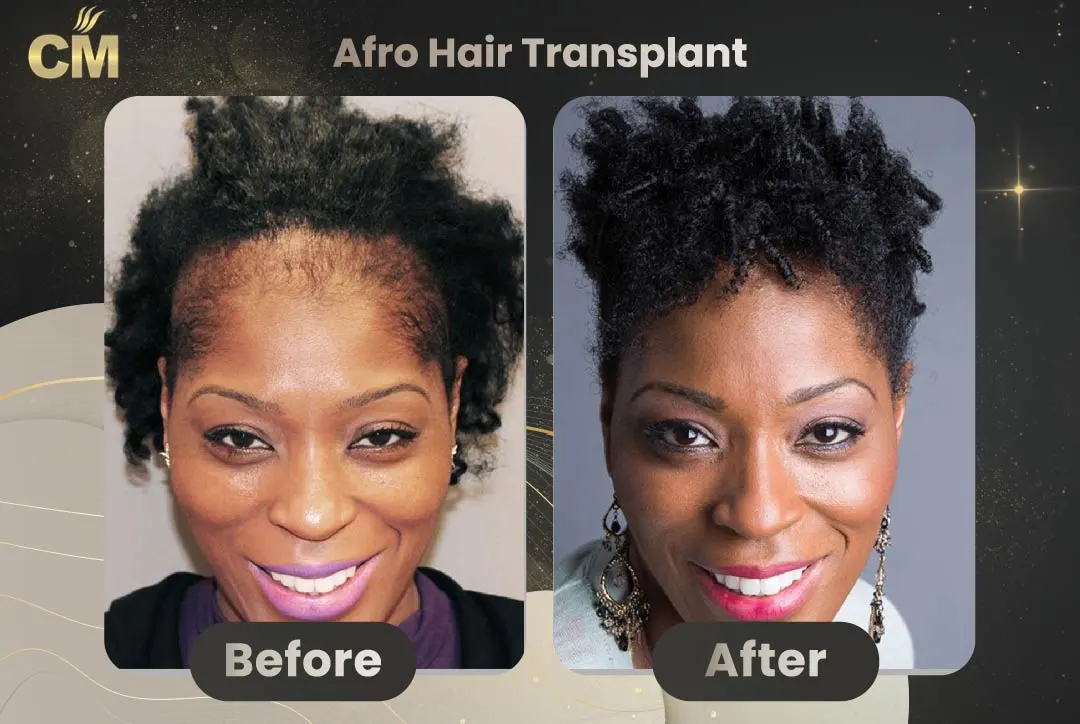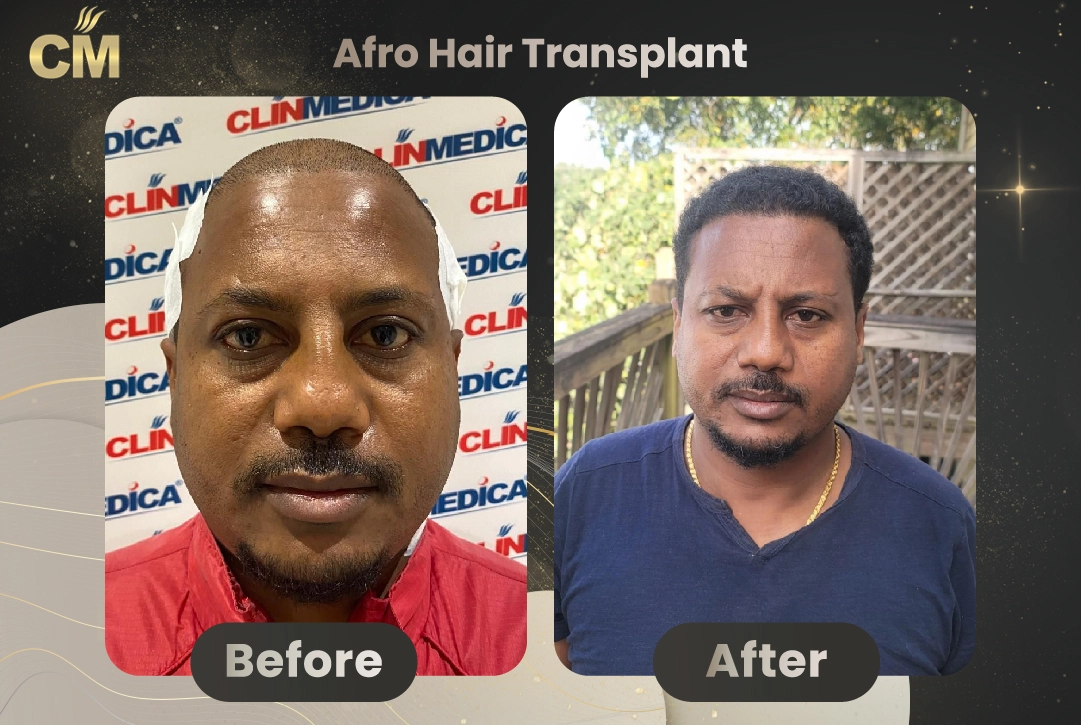Afro Hair Transplant Before and After
In this article, you will find pictures showcasing the results of Afro hair transplant operations. It also includes detailed information on how this procedure works and essential guidance on what to expect before and after treatment. Both male and female patients have achieved successful results with Afro hair transplants. This highlights the diversity of individuals who benefit from this treatment. The African American hair transplant is a specialized procedure designed to address the unique texture and curl pattern of afro textured hair. It requires tailored techniques to preserve the natural appearance and minimize damage. Clinics in Turkey have proven expertise in addressing the unique characteristics of Afro hair, making it an ideal destination for transformative hair restoration. Beverly Hills Hair Restoration showcases before and after results of afro hair transplants to illustrate effectiveness.
Your Afro Hair Transplant Experience in Turkey
A Step-by-Step Guide
Clinics in Turkey are renowned for their expertise in hair transplantation. They offer a seamless and supportive experience for international patients. From the initial consultation to post-operative care, each step ensures comfort, safety, and optimal results.
Many clinics use specialized and advanced techniques tailored specifically for African American patients. These methods address the unique characteristics of textured and curly hair to achieve natural-looking outcomes. The optimal techniques for African American hair transplants involve using microscopes during graft preparation, ensuring precision and minimizing damage to the delicate hair follicles.
Personalized Consultation
Your journey begins with a comprehensive consultation with a hair transplant specialist. They assess your hair loss, discuss your goals, and create a custom treatment plan tailored to your hair type and desired outcome.
Many clinics offer a free consultation for African American individuals. This helps address the unique characteristics of textured or curly hair and discusses specialized hair restoration options. Schedule your consultation today to take the first step toward your personalized hair restoration plan.
The Afro Hair Transplant Procedure
The preferred technique for afro hair transplants is often Follicular Unit Extraction (FUE). Follicular Unit Transplantation (FUT) is also a common option. Both procedures extract individual hair follicles precisely from a donor area, typically the back of your head. FUE suits individuals who prefer short hairstyles, as it minimizes visible scarring. This is especially important for African American hair, as the unique curl pattern and texture require specialized techniques to preserve the integrity of hair follicles during extraction and implantation.
The number of grafts needed depends on the extent of hair loss and hair characteristics, such as density and texture. Careful placement of transplanted follicles into the recipient area is crucial for achieving natural-looking results. Each graft in afro hair transplants must be meticulously placed to replicate the natural hair growth patterns due to the unique characteristics of the hair.
Recovery and Aftercare
Your surgeon will provide detailed post-operative care instructions to ensure successful hair growth and minimal scarring. Recovery from afro hair transplants can present challenges due to the curly nature of the hair. You must protect both transplanted follicles and recipient sites during healing. Following these guidelines diligently is key to achieving optimal results.
Natural, Beautiful Results
Hair growth takes time, but you can expect gradual progress that blends seamlessly with your existing hair. Over several months, you will enjoy a fuller, thicker head of hair that looks and feels entirely your own.
Specialized techniques preserve the unique curl pattern and texture of Afro hair throughout the procedure to achieve natural-looking results. The unique curl pattern of afro hair can result in tension and torsion during extraction, increasing the risk of follicle damage. This makes the use of advanced techniques essential for successful outcomes.
Selecting the Right Clinic
Your Key to Success
Thoroughly research and select a reputable clinic with a proven track record of successful afro hair transplants. Clinics like Beverly Hills Hair Restoration provide effective solutions and a range of hair loss treatment options tailored for textured and Afro hair types. Consider these factors: Hair transplant prices may be different in other countries, often being more affordable in places like Turkey, India, or Mexico. The cost of Afro hair restoration can vary from $4,000 to over $15,000 depending on various circumstances.
Experience
Choose a clinic with extensive experience specifically in afro hair transplantation. Experienced clinics have successfully treated African American men, African American male, and African American women with various hair loss concerns. During the consultation, patients should ask about the experience and techniques of the transplant surgeon.
Credentials
Ensure your surgeon holds certification from recognized medical boards and has a strong reputation in the field.
Transparency
Request a clear breakdown of costs and avoid clinics with hidden fees or unrealistic claims. The number of grafts needed is a key factor in determining the overall cost, as it depends on the extent of hair loss and individual hair characteristics. On average, hair transplant procedures can involve anywhere from 1,000 to 4,000 grafts or more. The cost per graft for a hair transplant can range from around $2 to $10 or more.
Comprehensive Support
Opt for a clinic that offers comprehensive aftercare and ongoing support throughout your hair restoration journey.
Embrace Your Renewed Confidence
An afro hair transplant in Turkey is more than a medical procedure; it is a transformative experience. It restores your hair, your confidence, and your natural beauty. With the right clinic and surgeon, you can achieve a fuller, thicker head of hair that empowers you to feel your best.
What to Expect After an Afro Hair Transplant
Recovery Process
The recovery process for an Afro hair transplant is similar to other types but involves specific considerations due to the nature of the hair. Patients typically experience mild redness, swelling, or discomfort in the donor and recipient areas for the first few days. Special care protects both donor and recipient sites during recovery. Following post-operative instructions ensures proper healing and optimal results. Preparation for an afro hair transplant includes moisturizing the scalp and massaging it for improved blood flow.
Afro hair transplants effectively restore density in thinning or lost hair areas and provide natural-looking results. Scabbing forms around transplanted grafts but usually falls off within 7–10 days. Most patients return to work and light activities within a week. Full recovery may take several months as transplanted hair begins to grow.
Resuming Physical Activities After Surgery
Avoid strenuous activities like heavy lifting and sports for at least two weeks after the procedure. Activities causing sweating or pressure on the scalp can disrupt healing. Light activities, such as walking, can resume shortly after surgery. Your surgeon will provide instructions on when to return to your normal exercise routine.
Maintaining the Results of an Afro Hair Transplant
Maintaining results requires careful aftercare and a healthy lifestyle. Use hair care products designed for Afro hair to promote growth and maintain scalp health. Choose products formulated for textured and African American hair to address curl pattern, fragility, and scalp needs. Avoid chemical treatments like relaxers for several months after the transplant to protect newly implanted grafts. Regular follow-up appointments help ensure long-term success.
Scarring After an Afro Hair Transplant
Afro hair often covers minor scarring naturally. The curly texture and unique pattern help conceal scars, as tight curls make marks less noticeable. Techniques like FUE (Follicular Unit Extraction) or DHI (Direct Hair Implantation) leave minimal scarring with small puncture marks that heal quickly. Proper care helps scars fade over time, and tight curls enhance the natural appearance.
Understanding the Risks of an Afro Hair Transplant
As with any surgery, risks include infection, scarring, or shock loss (temporary shedding). Choosing an experienced surgeon and following post-operative care minimizes these risks.
Afro hair transplants present challenges like curved hair follicles and limited donor areas, requiring specialized and advanced techniques to achieve optimal results and reduce complications.
The curvature of hair grafts makes the procedure more complex. Selecting a clinic like ClinMedica, with expertise in this area, is critical.
Benefits of an Afro Hair Transplant
Benefits include restoring hair density in affected areas, achieving natural-looking results, and boosting self-confidence. Afro hair transplants offer effective solutions and excellent results. They serve as reliable hair loss treatment for thinning or balding areas. The procedure is highly effective for traction alopecia, caused by tight hairstyles. With proper care, transplanted hair grows naturally for a lifetime, providing a permanent solution.
Who Is Not a Suitable Candidate for an Afro Hair Transplant?
Not everyone is an ideal candidate. Patients with insufficient donor hair, advanced scalp hair loss, or certain medical conditions like uncontrolled diabetes or autoimmune diseases may not qualify. Those with unrealistic expectations should reconsider. Individuals with lost or thinning hair, including African Americans with unique hair characteristics, should consult a specialist to determine suitability. A detailed consultation with your surgeon will help decide if the procedure is right for you.
Things to Do After an Afro Hair Transplant
Key Post-Operative Care Steps
Follow your surgeon’s post-operative care instructions carefully. Keep your scalp clean and avoid touching or scratching treated areas. You may receive specialized shampoos or medicated products to aid healing and promote growth. Hydration and a balanced diet support recovery.
Afro Hair Transplant Recovery Timeline
Avoid tight hairstyles like braids or cornrows that pull on the scalp during recovery. Do not expose your scalp to direct sunlight. Refrain from harsh chemicals or heat styling tools for several months. Avoid swimming, saunas, and vigorous activities for at least two weeks to protect new grafts.
How Long Should You Stay in Istanbul for the Procedure?
International patients traveling to Turkey should stay in Istanbul for at least 2–3 days. This allows time for the procedure and necessary follow-ups to ensure healing before returning home.
How Many Nights Will You Stay in the Hospital?
Afro hair transplants are outpatient procedures. You can return to your accommodation the same day. No overnight hospital stay is needed, but follow-up appointments are required in the days after surgery.
Pre-Procedure Instructions for International Patients
If traveling to Turkey for an Afro hair transplant, prepare thoroughly:
- Complete all necessary medical tests and provide your surgeon with a detailed medical history, including medications and supplements.
- Pack loose, comfortable clothing and a hat to protect your scalp after surgery.
- Arrange flexible flights in case recovery takes longer than expected.
- Carry all relevant medical records, including test results and surgical clearances.
Do You Need a Companion for the Procedure?
A companion is not mandatory but can be helpful, especially during the first recovery day. They can assist with daily tasks, provide support, and ensure comfort during healing. If traveling alone, consider arranging post-operative care at your accommodation.
What Should You Do After an Afro Hair Transplant?
Post-Surgery Instructions
Your surgeon will provide specific scalp care instructions after the transplant. Avoid washing your hair for the first few days and follow prescribed aftercare products. Attend follow-up appointments to monitor progress and ensure optimal results.
Traveling Home After Surgery
Guidelines for Airport and In-Flight Care
If flying home after an Afro hair transplant, especially on long flights, follow these guidelines:
- Timing Your Flight
Stay in Istanbul for at least 3–5 days after the procedure to allow initial healing and follow-up care before flying home. - In-Flight Care
During the flight:
- Stay hydrated by drinking plenty of water.
- Avoid touching your scalp to protect grafts.
- Wear loose, comfortable clothing to avoid scalp pressure.
- Carry prescribed medications in your carry-on and take them as directed.
- Airport Assistance
Request help with luggage or a wheelchair to avoid overexertion. Avoid lifting heavy bags or strenuous activities that stress your scalp. - Long-Haul Flight Considerations
Take frequent breaks to stretch and move to maintain circulation. Plan additional rest days after returning home to continue healing before resuming normal activities.
Following these post-surgery and travel guidelines ensures a smooth recovery and safe journey home. ClinMedica provides comprehensive care instructions to help you achieve the best results.
When Does Hair Grow After Afro Hair Transplant?
Transplanted hair starts to grow after the third month when grafts settle under the skin and begin producing hair. Patients see satisfactory results by the sixth month. Hair growth continues gradually until completing a full year.
African American hair transplants require specialized techniques for optimal results due to the unique curl pattern and fragility of afro textured hair.
Patients may need to be more careful with nutrition and protection to support hair growth. Today, improvements appear more quickly with such measures.
In the Afro hair transplantation method, patients may adopt energy-giving nutritional habits to speed recovery. Various health centers in Turkey offer these services with desired quality. Many prefer qualified centers that meet high expectations.
Afro hair transplants in Turkey require specialized knowledge and techniques. With the right expertise and care, natural-looking results are achievable.
When Will You See the Final Results?
Final results take time to fully develop. Patients see new hair growth around 3–4 months after the procedure. Full results appear between 9–12 months. Transplanted hair grows naturally, blending seamlessly with existing Afro hair.

